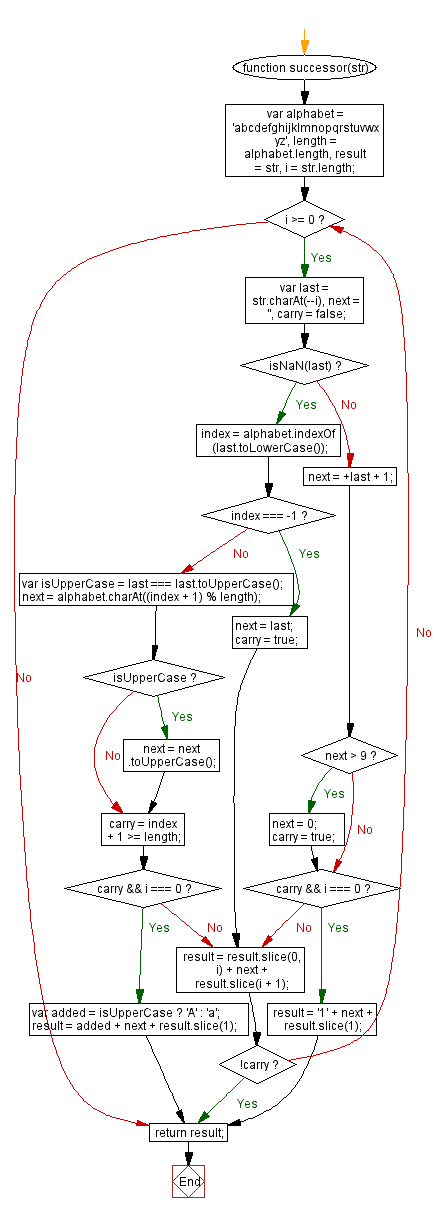JavaScript: Get the successor of a string
JavaScript String: Exercise-48 with Solution
Write a JavaScript function to get the successor of a string.
Note: The successor is calculated by incrementing characters starting from the rightmost alphanumeric (or the rightmost character if there are no alphanumerics) in the
string. Incrementing a digit always results in another digit, and incrementing a letter results in another letter of the same case. If the increment generates a carry, the character to the left of it is incremented. This process repeats until there is no carry, adding an additional character if necessary.
Example:
string.successor("abcd") == "abce"
string.successor("THX1138") == "THX1139"
string.successor("<
string.successor("1999zzz") == "2000aaa"
string.successor("ZZZ9999") == "AAAA0000"
Test Data:
console.log(successor('abcd'));
console.log(successor('3456'));
"abce"
"3457"
Sample Solution:-
HTML Code:
<!DOCTYPE html>
<html>
<head>
<meta charset="utf-8">
<title>JavaScript function to get the successor of a string</title>
</head>
<body>
</body>
</html>
JavaScript Code:
function successor(str) {
var alphabet = 'abcdefghijklmnopqrstuvwxyz',
length = alphabet.length,
result = str,
i = str.length;
while(i >= 0) {
var last = str.charAt(--i),
next = '',
carry = false;
if (isNaN(last)) {
index = alphabet.indexOf(last.toLowerCase());
if (index === -1) {
next = last;
carry = true;
}
else {
var isUpperCase = last === last.toUpperCase();
next = alphabet.charAt((index + 1) % length);
if (isUpperCase) {
next = next.toUpperCase();
}
carry = index + 1 >= length;
if (carry && i === 0) {
var added = isUpperCase ? 'A' : 'a';
result = added + next + result.slice(1);
break;
}
}
}
else {
next = +last + 1;
if(next > 9) {
next = 0;
carry = true;
}
if (carry && i === 0) {
result = '1' + next + result.slice(1);
break;
}
}
result = result.slice(0, i) + next + result.slice(i + 1);
if (!carry) {
break;
}
}
return result;
}
console.log(successor('abcd'));
console.log(successor('3456'));
Sample Output:
abce 3457
Flowchart:

Live Demo:
See the Pen JavaScript Get the successor of a string-string-ex-48 by w3resource (@w3resource) on CodePen.
Improve this sample solution and post your code through Disqus
Previous: Write a JavaScript function to test whether a string ends with a specified string.
Next: Write a JavaScript function to get unique guid (an acronym for 'Globally Unique Identifier’) of the specified length, or 32 by default.
What is the difficulty level of this exercise?
Test your Programming skills with w3resource's quiz.
JavaScript: Tips of the Day
How to insert an item into an array at a specific index (JavaScript)?
What you want is the splice function on the native array object.
arr.splice(index, 0, item); will insert item into arr at the specified index (deleting 0 items first, that is, it's just an insert). In this example we will create an array and add an element to it into index 2:
var arr = []; arr[0] = "Jani"; arr[1] = "Hege"; arr[2] = "Stale"; arr[3] = "Kai Jim"; arr[4] = "Borge"; console.log(arr.join()); arr.splice(2, 0, "Lene"); console.log(arr.join());
Ref: https://bit.ly/2BXbp04
- New Content published on w3resource:
- HTML-CSS Practical: Exercises, Practice, Solution
- Java Regular Expression: Exercises, Practice, Solution
- Scala Programming Exercises, Practice, Solution
- Python Itertools exercises
- Python Numpy exercises
- Python GeoPy Package exercises
- Python Pandas exercises
- Python nltk exercises
- Python BeautifulSoup exercises
- Form Template
- Composer - PHP Package Manager
- PHPUnit - PHP Testing
- Laravel - PHP Framework
- Angular - JavaScript Framework
- Vue - JavaScript Framework
- Jest - JavaScript Testing Framework
